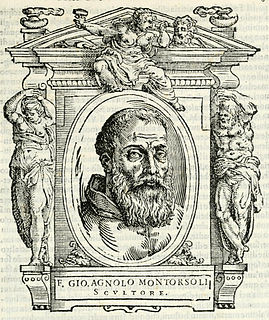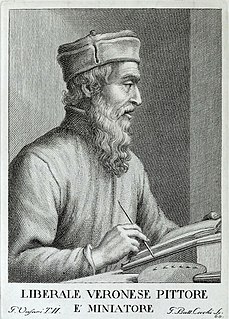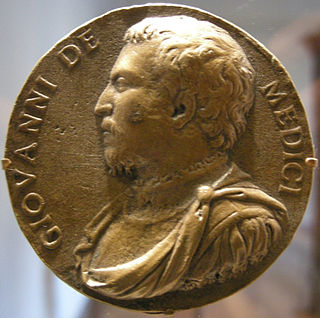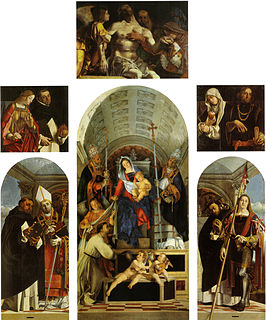
Giorgio Vasari was an Italian painter, architect, engineer, writer, and historian, best known for his Lives of the Most Excellent Painters, Sculptors, and Architects, considered the ideological foundation of art-historical writing, and the basis for biographies of several Renaissance artists, including Leonardo da Vinci. Vasari designed the Tomb of Michelangelo in the Basilica of Santa Croce, Florence that was completed in 1578. Based on Vasari's text in print about Giotto's new manner of painting as a rinascita (rebirth), author Jules Michelet in his Histoire de France (1835) suggested adoption of Vasari's concept, using the term Renaissance to distinguish the cultural change. The term was adopted thereafter in historiography and still is in use today.

Andrea di Cione di Arcangelo, better known as Orcagna, was an Italian painter, sculptor, and architect active in Florence. He worked as a consultant at the Florence Cathedral and supervised the construction of the facade at the Orvieto Cathedral. His Strozzi Altarpiece (1354–57) is noted as defining a new role for Christ as a source of Catholic doctrine and papal authority.

Antonio Gamberelli (1427–1479), nicknamed Antonio Rossellino for the colour of his hair, was an Italian sculptor. His older brother, from whom he received his formal training, was the sculptor and architect Bernardo Rossellino.

Andrea dal Monte Sansovino or Andrea Contucci del Monte San Savino was an Italian sculptor active during the High Renaissance. His pupils include Jacopo Sansovino.

Giovanni Angelo Montorsoli, also known as Giovann'Agnolo Montorsoli, was a Florentine sculptor and Servite friar. He is today as often remembered for his restorations of famous classical works as his original creations.

Altichiero da Verona, also called Aldighieri da Zevio, was an Italian painter of the Gothic style.

Giulio Romano, also known by his real name of Giulio Pippi, was an Italian painter and architect. He was a pupil of Raphael, and his stylistic deviations from High Renaissance classicism help define the 16th-century style known as Mannerism. Giulio's drawings have long been treasured by collectors; contemporary prints of them engraved by Marcantonio Raimondi were a significant contribution to the spread of 16th-century Italian style throughout Europe.

Pisanello, born Antonio di Puccio Pisano or Antonio di Puccio da Cereto, also erroneously called Vittore Pisano by Giorgio Vasari, was one of the most distinguished painters of the early Italian Renaissance and Quattrocento. He was acclaimed by poets such as Guarino da Verona and praised by humanists of his time, who compared him to such illustrious names as Cimabue, Phidias and Praxiteles.
Events from the year 1574 in art.

Liberale da Verona (1441–1526) was an Italian painter of the Renaissance period, active mainly in Verona.

The Lives of the Most Excellent Painters, Sculptors, and Architects, often simply known as The Lives, is a series of artist biographies written by 16th-century Italian painter and architect Giorgio Vasari, which is considered "perhaps the most famous, and even today the most-read work of the older literature of art", "some of the Italian Renaissance's most influential writing on art", and "the first important book on art history".
Mino del Reame, also known as Mino dal Reame, was a 15th-century Neapolitan Italian Renaissance sculptor from Naples.

Jacopo Torni (1476–1526), also known as Jacobo Fiorentin, L'Indaco, and Jacopo dell'Indaco, was an Italian (Florentine) painter, sculptor and architect.

Francesco Bonsignori, also known as Francesco Monsignori, was an Italian painter and draughtsman, characterized by his excellence in religious subjects, portraits, architectural perspective and animals. He was born in Verona and died in Caldiero, a city near Verona. Bonsignori's style in early period was under the influence of his teacher Liberale da Verona. After becoming the portraitist and court artist to the Gonzaga family of Mantua in 1487, his style was influenced by Andrea Mantegna, who also worked for Francesco Gonzaga from the 1480s. They collaborated to execute several religious paintings, mainly with the theme of Madonna and Child. The attribution of theportrait of a Venetian Senator was debatable until the last century because of the similarity in techniques used by Bonsignori and his teacher Mantegna. During the phase of his career in Mantua, there is an undocumented period between 1495 and July 1506 with no official record regarding his activities by the court of Mantua. Bonsignori's late style was decisively influenced by Lorenzo Costa in terms of form and color. He produced his last monumental altarpiece the Adoration of the Blessed Osanna Andreasi in 1519 shortly before his death.
Events from the year 1568 in art.

Danese Cattaneo was an Italian sculptor and medallist, active mainly in the Veneto Region.

The Recanati Polyptych is a painting by the Italian Renaissance painter Lorenzo Lotto, executed in 1506-1508 and housed in the Civic Museum of Villa Colloredo Mels, Recanati, Italy. The work is dated and signed Laurent[ius] Lotus MDVIII.

Self-portrait in a Convex Mirror is a painting by the Italian late Renaissance artist Parmigianino. It is housed in the Kunsthistorisches Museum, Vienna, Austria.

An anonymous author known as the Anonimo Gaddiano, Anonimo Magliabechiano, or Anonimo Fiorentino is the author of the Codice Magliabechiano or Magliabechiano, a manuscript with 128 pages of text, probably from the 1530s and 1540s, and now in the Central National Library of Florence. It includes brief biographies and notes on the works of Italian artists, mainly those active in Florence during the Middle Ages. Among several other suggestions, the anonymous author has been suggested to be Bernardo Vecchietti (1514–1590), a politician of the court of Cosimo I. The author clearly had intimate access to the Medici court.

The Libro de' Disegni was a collection of drawings gathered, sorted and grouped by Giorgio Vasari whilst writing his Lives of the Most Excellent Painters, Sculptors, and Architects. By the time of his death in 1574 it is thought to have contained around 526 drawings, of which 162 are now in the Louvre and 83 in the Nationalmuseum, Stockholm. There are also drawings from the Libro in the prints and drawings departments of the Uffizi, the British Museum, the Albertina, the National Gallery of Art and other institutions.

















